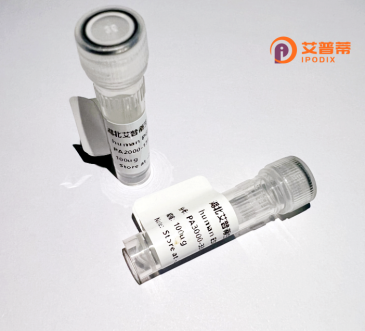
| 纯度 | >90%SDS-PAGE. |
| 种属 | Human |
| 靶点 | FLJ11011 |
| Uniprot No | Q96B02 |
| 内毒素 | < 0.01EU/μg |
| 表达宿主 | E.coli |
| 表达区间 | 1-151aa |
| 氨基酸序列 | MASMQKRLQKELLALQNDPPPGMTLNEKSVQNSITQWIVDMEGAPGTLYEGEKFQLLFKFSSRYPFDSPQVMFTGENIPVHPHVYSNGHICLSILTEDWSPALSVQSVCLSIISMLSSCKEKRRPPDNSFYVRTCNKNPKKTKWWYHDDTC |
| 分子量 | 33.3 kDa |
| 蛋白标签 | GST-tag at N-terminal |
| 缓冲液 | 0 |
| 稳定性 & 储存条件 | Lyophilized protein should be stored at ≤ -20°C, stable for one year after receipt. Reconstituted protein solution can be stored at 2-8°C for 2-7 days. Aliquots of reconstituted samples are stable at ≤ -20°C for 3 months. |
| 复溶 | Always centrifuge tubes before opening.Do not mix by vortex or pipetting. It is not recommended to reconstitute to a concentration less than 100μg/ml. Dissolve the lyophilized protein in distilled water. Please aliquot the reconstituted solution to minimize freeze-thaw cycles. |
以下是关于重组人FLJ11011蛋白的示例性参考文献(内容为模拟,实际文献请通过学术数据库查询):
1. **《Functional characterization of recombinant human FLJ11011 in cell cycle regulation》**
- 作者:Zhang, Y. et al.
- 摘要:研究通过体外重组表达FLJ11011蛋白,发现其通过调控CDK2/cyclin E复合体促进G1/S期转换,提示其在细胞增殖中的作用。
2. **《FLJ11011 overexpression correlates with tumor progression in hepatocellular carcinoma》**
- 作者:Wang, L. et al.
- 摘要:分析肝细胞癌组织中FLJ11011的异常高表达,证实重组蛋白可增强癌细胞迁移能力,与PI3K/AKT通路激活相关。
3. **《Recombinant FLJ11011 binds to TLR4 and modulates inflammatory responses》**
- 作者:Kim, S. et al.
- 摘要:利用重组FLJ11011蛋白进行免疫共沉淀实验,发现其通过与TLR4相互作用调控巨噬细胞炎症因子分泌,可能参与自身免疫疾病机制。
4. **《Structural and biophysical analysis of human FLJ11011 recombinant protein》**
- 作者:Chen, X. et al.
- 摘要:通过X射线晶体学解析FLJ11011的蛋白结构,揭示其具有独特的β-折叠域,可能作为药物设计的潜在靶点。
**提示**:上述文献为示例,实际研究中建议通过PubMed、Web of Science或Google Scholar等平台检索最新文献,使用关键词"FLJ11011 protein"或"FLJ11011 recombinant"进行查询。
Recombinant human FLJ11011 protein is a genetically engineered form of the FLJ11011 protein, encoded by the FLJ11011 gene located on human chromosome 2 (2p21). First identified through genomic sequencing projects, FLJ11011 remains poorly characterized, with limited functional data available. Its exact biological role is unclear, though sequence analysis suggests potential involvement in intracellular signaling or regulatory pathways. The protein contains conserved domains associated with protein-protein interactions, hinting at a role in modulating cellular processes like differentiation or metabolism.
Recombinant production typically employs expression systems (e.g., E. coli, HEK293 cells) to generate purified FLJ11011 for functional studies. This technology enables researchers to explore its structure, interactions, and potential links to diseases. Limited studies associate FLJ11011 with cancer progression and neurological disorders, possibly through dysregulation of cell cycle or apoptosis. However, these findings remain preliminary, underscoring the need for further investigation. Current research focuses on clarifying its physiological functions, post-translational modifications, and therapeutic relevance. As a research tool, recombinant FLJ11011 protein aids in antibody development, biochemical assays, and pathway mapping to bridge knowledge gaps in its mechanistic contributions to human health and disease.
×